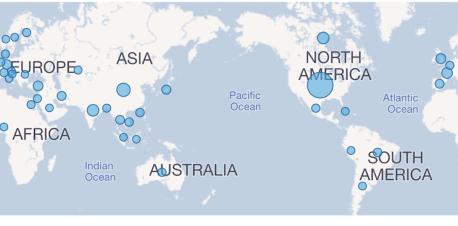
UNICEF Launches Online Tool Tracking COVID-19 Vaccine Market
Want to know how many COVID-19 vaccines are in development, and by whom? Curious about production volumes and bilateral supply agreements? How about price per dose? UNICEF's new interactive dashboard puts all the latest market data in one place.
UNICEF has launched a new interactive tool for tracking the rapidly evolving COVID-19 vaccine market — an online, dynamic dashboard presenting all the latest data about vaccines in the pipeline, manufacturers' production capacities, supply agreements between companies and countries and much, much more.
Offering a dizzying array of charts, graphs and tables, the COVID-19 Vaccine Market Dashboard covers detailed information that is already publicly available, drawing from numerous sources that UNICEF deems reliable. The dashboard is not intended to guide country decision-making, or imply endorsement of a particular product.

Screen shot taken Dec. 31, 2020 from UNICEF's COVID-19 Vaccine Market Dashboard, showing bilateral/multilateral supply agreements (in doses) by vaccine developer. The COVAX supply assumes an even split of the 1.1 billion AstraZeneca or Novavax doses (200 million secured and options for up to 900 million more) manufactured by Serum Institute of India for COVAX Facility. © UNICEF
In its next iteration, the dashboard will track progress towards the goal of securing 2 billion COVID-19 vaccine doses by the end of 2021, as established by the COVAX Facility, and to communicate the status of procurement and deliveries by UNICEF and other national and institutional buyers. UNICEF is leading global procurement and delivery of COVID-19 vaccines to 92 low- and middle-income countries — while also supporting procurement in 97 high-income ones — on behalf of the Facility, which was formed to ensure timely, equitable access to COVID-19 vaccines for all countries.
Vaccine development is just a first step in a long road — albeit fast-tracked in this case — to widespread use. New vaccines must be tested, approved, licensed, produced at scale and distributed before they can be administered to people. Distribution of the Pfizer/BioNTech vaccine is underway in some countries, including the U.S. and the U.K.
Gearing up for the global COVID-19 vaccine launch
The World Health Organization will determine which vaccines are delivered by UNICEF under the COVAX plan. The Facility announced on Dec. 18 that it had agreements in place to secure enough doses to meet its goal for 2021, which is to have 20 percent of the world's population immunized by year end.
In the meantime, UNICEF is taking an all-hands-on-deck approach to prepare for roll out, mapping out the logistics of transporting up to 850 tons of COVID-19 vaccines per month; installing over 70,000 cold chain fridges; stockpiling syringes; and reinforcing public trust and confidence in vaccines through communication and advocacy campaigns, among other measures.

Dr. Frances Vulivuili, UNICEF Health and Nutrition Specialist, prepares cold boxes for vaccination teams at Tupua Tamasese Meaole Hospital in Apia, Samoa. Cold boxes play a vital role in maintaining the cold chain, a series of temperature controls necessary to maintain vaccine potency from manufacture through innoculation. © UNICEF/UNI232382/Stephen/Infinity Images
Learn more about UNICEF's role in COVID-19 vaccine distribution and delivery worldwide.
To receive updates to the COVID-19 Vaccine Market Dashboard via email, subscribe to UNICEF's newsletter.
Top image: A screen shot from the UNICEF COVID-19 Vaccine Market Dashboard, which includes a map illustrating the number of vaccine developers by country. Graphic © Microsoft Corporation
HOW TO HELP
There are many ways to make a difference
War, famine, poverty, natural disasters — threats to the world's children keep coming. But UNICEF won't stop working to keep children healthy and safe.
UNICEF works in over 190 countries and territories — more places than any other children's organization. UNICEF has the world's largest humanitarian warehouse and, when disaster strikes, can get supplies almost anywhere within 72 hours. Constantly innovating, always advocating for a better world for children, UNICEF works to ensure that every child can grow up healthy, educated, protected and respected.
Would you like to help give all children the opportunity to reach their full potential? There are many ways to get involved.



